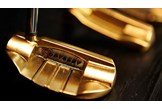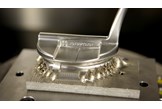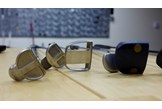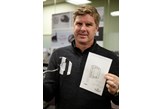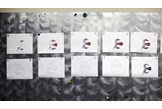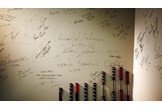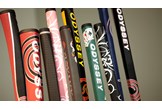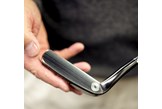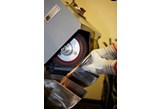Inside Odyssey: Part 1
Published: Last updated:
Putting is golf’s greatest contradiction. Easy to do, impossible to master. Simple, but complex. Satisfying, but maddening. An open book and a complete mystery. It is the same story for the high handicapper and the world-class pro. A maze, a conundrum, a place where a clever man like Austie Rollinson can spend 20 years looking for a definitive answer, know he will almost certainly never find it, and yet still be inspired to keep looking.
“My parents were both artistic (my dad was an art major and my mother was an interior designer) so it was only natural that I was always drawing things when I was a kid. I loved doing things with my hands, creating stuff from scratch and building models,’’ says Rollinson, the chief designer for Odyssey. “I grew up playing golf. I have a background in physics. When I left college and the time came to find a job I thought to myself ‘designing golf clubs?’ ‘Now that would be a cool thing to do for a living’.”
How cool? Well, take a flight to the beautiful city of San Diego, California, then drive 40 miles north, along the I-5 freeway, until you get to Carlsbad. Turn right at junction 47, drive for a mile, and then turn left up the hill, where you will find the global headquarters of Callaway Golf. It looks impressive from the outside; modern and quietly understated. Inside, it seems like a million other offices. But look a little closer, and you will see the evidence of golfing innovation – draughtsmens’ imaginings of the golf club of the future, pinned on the walls and prototype driver heads lined up on shelves. Listen a little harder and you will hear the constant buzz of the sales and marketing people at work. Design, design, design. Make, make, make. Sell, sell, sell. “Mr Callaway used to say marketing gets the guy through the door of the shop but then it is up to guys like us – the research and design guys – to come up with a club that performs well, that the man in the street will like when he picks up and uses it; and that will make him want to put his money down,” Rollinson continued.
Twenty years ago Rollinson wrote a speculative letter to Callaway asking for a job and was asked to come for an interview. He must have said something right because he was hired and he must have done something right since because, 20 years later, he is still around and is now the chief designer for Odyssey, the company’s putter division. Here, in this corner of the golfing universe, he heads a team devoted to resolving golf’s greatest contradiction. There have been some giant leaps forward and there have been some backward steps (or as Rollinson likes to say with a self-depricating grin, “A few things that might not have done as well as we hoped they would”). But more than anything, there has been change, mostly as a result of giving people the chance to follow their dreams and hunches.
To illustrate this point, Rollinson recalls the search for a device to measure the launch conditions of a golf ball back in the mid-1990s. “I had bought a system in Japan, a strobe device that did the job, but we wanted something that was more robust,” he said. “At that time we were thinking it would be great to find something that didn’t use video. My boss at the time had a friend at NASA who built stuff at the weekends just to keep himself amused and he said ‘I can build you a radar to do that’. So we paid him a couple of thousand bucks and he came over with this cone with the tinfoil on it and the oscilloscope. Anyway, we were making a little bit of progress with it and then the company president came along, took a look and said, ‘I’m a fan of Star Trek, like everyone else, but come on, measuring a golf ball with radar – that’s ridiculous. I don’t want you spending money on stuff like this’. These days Trackman, the industry standard, uses radar-based technology. The point is that no matter how ridiculous something seems at the time, if you give someone the chance to run with the idea, you never know what can happen. It can be a lot of fun for the guys who are looking at a problem and trying to discover ways to solve it. And it can be good for business.”
Any great golf club begins with an idea and the most iconic golf club ever produced by Odyssey, the Two-Ball Putter (global sales, 4,000,000 and counting), began life in the mind of the putting guru Dave Pelz, who patented and built a prototype putter which was, in essence, constructed to look like three golf balls lined up together. The aim was to help the golfer more accurately align a fourth ball (his actual golf ball). It was an ingenious idea on Pelz’s part and one for which he was well compensated by Odyssey. Rollinson said: “It was supposed to be a game-improvement putter, but the tour pros really embraced it. That was surprising to us. Our original forecast was really low on it. That first year, we sold 10 times what we thought we would sell.”
But a prototype putter is one thing; a putter that is sellable, marketable, durable and, most importantly, legal (within the rules laid down by the R&A and USGA) is quite another. Rollinson charts the tortuous history of the Two-Ball through its 34 different “iterations”. That’s right – there were 34 different versions of the club before it finally hit the shops in 2001. “There was one guy here who was in industrial design, and he was really taken with Pelz’s initial concept and he kept going back to it and back to it,” Rollinson said. “At the time no-one here thought it was going to be the greatest putter in the history of the world, but we thought it was worthwhile to have one of the guys work on it as a pet project. We saw it as a club we might market as a “game improvement” type of thing. We thought we would sell around 30,000 worldwide.”

